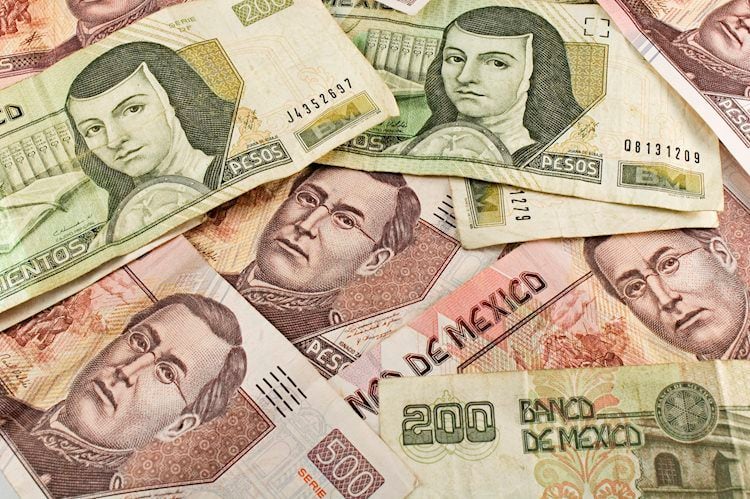- Mexican Peso declined more than 0.50% late in the North American session.
- Mexico’s calendar remains light, with the Peso weighed by solid US economic data.
- CME FedWatch Tool indicates a 46% probability of a 25 bps rate hike by the Fed in December.
Mexican Peso (MXN) experienced some depreciation against the US Dollar (USD) late in Tuesday’s North American session, triggered by a positive Retail Sales report from the United States (US), which led to a reevaluation of the possibility of another interest rate hike by the US Federal Reserve (Fed) during its December meeting, as indicated by the CME FedWatch Tool. Consequently, US Treasury bond yields increased, causing the USD/MXN exchange rate to rise to around 18.00, marking a gain of 0.75%.
The US Bureau of Economic Analysis (BEA) revised upward the Retail Sales figures for August in the US while reporting September’s data, which was slightly lower than the previous month but surpassed expectations. Additionally, the Fed released data indicating an increase in Industrial Production. Concerning monetary policy expectations, the CME FedWatch Tool suggests that traders are currently speculating that the Fed may not make any changes during its November meeting, but there is a possibility of a 25 basis points hike in December, with odds standing at approximately 46%
Aside from this, risk appetite improved on news of US President Joe Biden’s travel to Israel, where he would meet Israel’s PM and Arab leaders.
Daily Digest Market Movers: Mexican Peso falls as USD/MXN fluctuates around 18.00
- US Retail Sales in September grew by 0.7% MoM, above forecasts of 0.3%, but trailed upward revised August of 0.8%.
- Industrial Production rose 0.3% MoM, better than expected, and the previous month’s 0.0% reading.
- Mexico’s 2023 GDP is expected to hit 3.2%, according to the World Bank and the International Monetary Fund.
- New York Fed Empire State Manufacturing Index for October plunged to -4.6, higher than forecasts of -7 but worse than September’s 1.9 expansion.
- Philadelphia Fed President Patrick Harker commented the current level of rates kept house buyers on the sideline, highlighting that the Fed is likely done hiking rates.
- Chicago Fed President Austan Goolsbee said the fall in US inflation is not a bleep, according to the Financial Times.
- Inflation expectations for one year rose from 3.2% to 3.8%, while for five years jumped to 3% from 2.8%.
- Mexico’s Industrial Production (IP) for August improved by 5.2% YoY, exceeding forecasts of 4.6% and July’s 4.8% increase.
- Monthly, IP in Mexico rose 0.3% as expected but trailed the previous 0.5% reading.
- The US Consumer Price Index increased 3.7% YoY in September, unchanged from August but above forecasts of 3.6%.
- US core CPI dipped as expected to 4.1% from 4.3% in August.
- Mexico’s Consumer Price Index (CPI) grew by 4.45% YoY in September, slightly below the 4.47% estimated.
- The core CPI inflation in Mexico stood at a stickier 5.76% YoY, as widely estimated, but has broken below the 6% threshold.
- The Bank of Mexico (Banxico) held rates at 11.25% in September and revised its inflation projections from 3.5% to 3.87% for 2024, above the central bank’s 3% target (plus or minus 1%).
Technical Analysis: Mexican Peso descends as technical indicators support further USD/MXN upside
The Mexican Peso is trimming some of its Monday gains. Still, it remains below the 18.00 figure, maintaining its upward bias, unless the USD/MXN drops below the 200-day Simple Moving Average (SMA) at 17.75. In that case, the exotic pair could aim towards 17.50, followed by the 50-day SMA at 17.35. Contrarily, if the pair could re-test the 18.00 figure, which once broke, the pair could rally and test 18.20. Subsequent resistance would be the October 6 high of 18.48.
Banxico FAQs
The Bank of Mexico, also known as Banxico, is the country’s central bank. Its mission is to preserve the value of Mexico’s currency, the Mexican Peso (MXN), and to set the monetary policy. To this end, its main objective is to maintain low and stable inflation within target levels – at or close to its target of 3%, the midpoint in a tolerance band of between 2% and 4%.
The main tool of the Banxico to guide monetary policy is by setting interest rates. When inflation is above target, the bank will attempt to tame it by raising rates, making it more expensive for households and businesses to borrow money and thus cooling the economy. Higher interest rates are generally positive for the Mexican Peso (MXN) as they lead to higher yields, making the country a more attractive place for investors. On the contrary, lower interest rates tend to weaken MXN. The rate differential with the USD, or how the Banxico is expected to set interest rates compared with the US Federal Reserve (Fed), is a key factor.
Banxico meets eight times a year, and its monetary policy is greatly influenced by decisions of the US Federal Reserve (Fed). Therefore, the central bank’s decision-making committee usually gathers a week after the Fed. In doing so, Banxico reacts and sometimes anticipates monetary policy measures set by the Federal Reserve. For example, after the Covid-19 pandemic, before the Fed raised rates, Banxico did it first in an attempt to diminish the chances of a substantial depreciation of the Mexican Peso (MXN) and to prevent capital outflows that could destabilize the country.
